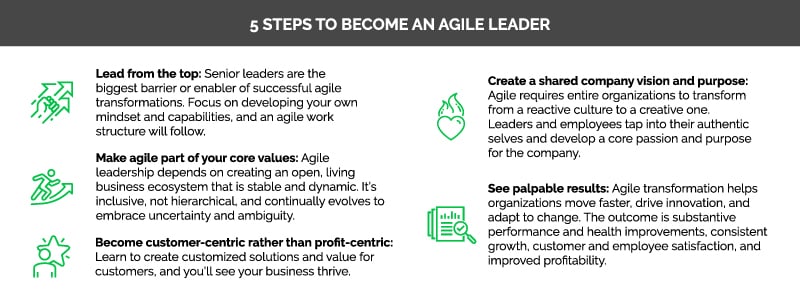5 Ways to Be a More Agile Leader

Here’s how leaders can adopt an agile approach and help their businesses thrive with change

After an incredibly difficult few years of business uncertainty and unprecedented changes in the business environment, companies are looking to get better equipped for the future. Agile transformation is a high priority for an increasing number of leaders and organizations who want to help their companies thrive in rapidly changing environments.
An agile leadership strategy focuses on complete engagement with all workers and ensures that your business is able to continually meet its ever-changing goals. Through a dense network of empowered teams, agile companies operate with high standards of accountability, expertise, alignment, transparency, and collaboration.
Can you become the kind of leader who fosters an agile company culture?
What is agile leadership?
Agile principles work to create a flexible organization capable of reacting quickly to unpredictable changes. The entire organization works in synchronicity to respond to change and adapt its structures and processes. Agile practices started in software development, where they were embraced for developing solutions through collaborative effort. An agile business is a company that embraces this agile philosophy at its core and becomes customer-centric.
This starts with agile leadership. You must foster a business that is all-inclusive and works hard to create a compelling culture and shared purpose.
What sets agile organizations apart from traditional ones?
While traditional organizations follow one or a few business models and run as machines with a structural hierarchy, an agile organization works as a stable and dynamic living system. Traditional organizations offer linear planning and control, agile organizations focus on the customer, adapt to environmental changes, and provide an open, inclusive model.
Agile organizations evolve and embrace uncertainty, while traditional business models are static and unwilling to change. In terms of projects and workflow, a traditional model works in a linear sequence of project phases, whereas in agile, workflow, projects, and tasks are iterative.
An agile workforce model is designed as a distributed, continually evolving system. There is greater transparency and leaner governance than traditional organizations. Also, an agile model is designed with smaller, more empowered units, as opposed to the larger, less granular structures of traditional organizations.
Agile leaders build a wide range of partners, not a powerful chain of command.
How to lead an agile business
- Leadership is the key enabler of successful agile transformation: In order to build an agile business, your leadership is critical. Agile leaders transform themselves, their teams, and the entire organization. You must shape a new culture across the organization based on creative mindsets of exploration, partnership, and abundance. Ultimately, you must foster understanding and conviction in your teams.
- Networked team building: Agile businesses use technology to build networks of empowered teams driven by a shared purpose. Your employees should feel openness and freedom, and they should be inspired by the energy and ideas of their team members.
- Adopt an agile approach to thrive with change: Agile businesses learn to react quickly and adapt to change with creative and customized solutions. Teams and workgroups have strong communication skills, allowing them to adjust rapidly. You must be willing to guide the business to respond and adapt with creative structures and processes.
- Become a people-centric leader: Connect employees to the company’s vision and purpose to create value for your customers. Focus on putting the customer before the profit.
- Develop “inner agility”: Agile businesses transform themselves from a reactive to a proactively creative mindset. They are able to create their reality through their authentic selves, their core passion and purpose. To be an agile leader, you must embrace these values in yourself and inspire your employees to embrace them, too.
What are the benefits of becoming an agile leader?
Agile businesses are quick to respond to changes in the marketplace or environment. They put the client experience at the heart of the work strategy; customer service thrives, and the business grows and scales.
Agile is an organizational model not just for software development teams anymore. It’s fast becoming the business philosophy that top leaders and successful companies are embracing to navigate into an uncertain future.
MetaGrowth Ventures helps business founders hire, train, and maintain top sales teams that you can trust to handle business development. This frees up your time and attention to focus on the strategic initiatives that will take your company to the next level. If you’re ready to take the next step, contact MetaGrowth Ventures today.
Written by
Josh Hirsch
